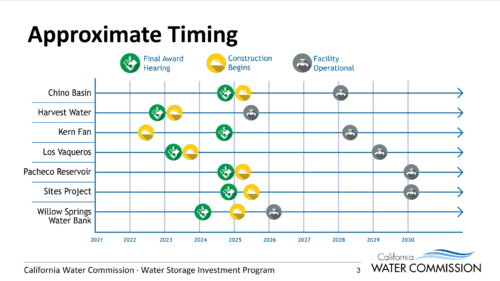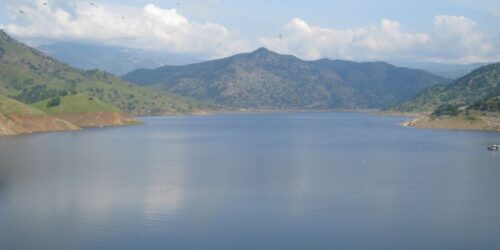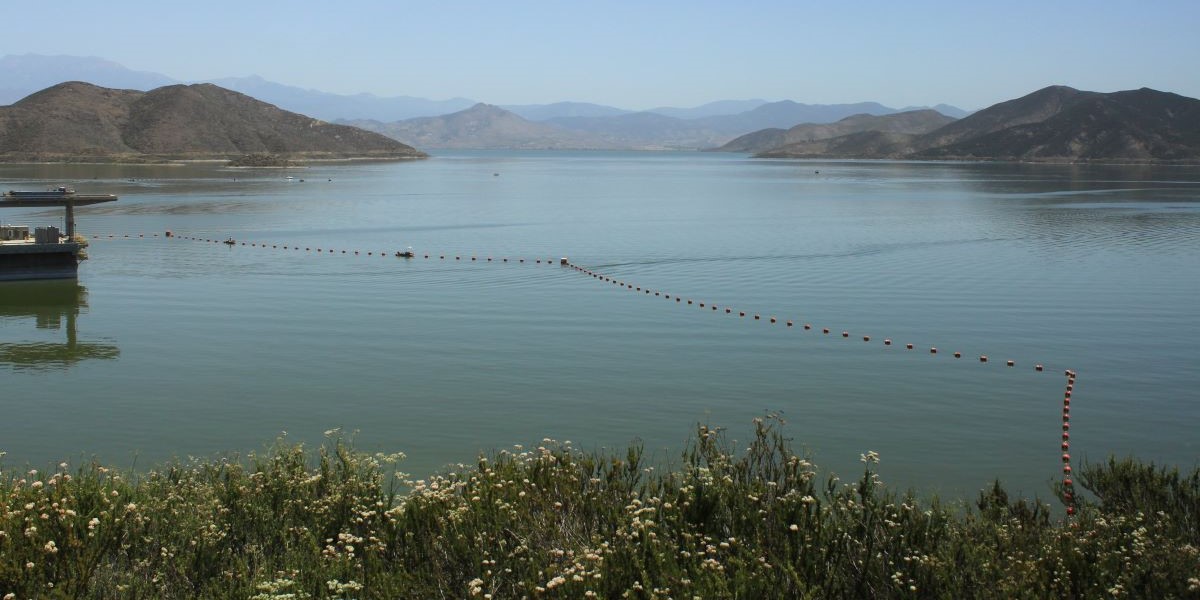The first of seven projects could see final funding awarded by the end of the year; other projects not until 2024
It’s a long road to the finish line for the seven water storage projects in the California Water Commission’s Water Storage Investment Program. In 2014, voters approved Proposition 1, which dedicated $2.7 billion for investments in the public benefits of water storage projects. In July 2018, the Commission determined the amount of funding available to each project based on the public benefits the project would provide. The selected projects include expanding existing reservoirs, building new reservoirs, and boosting groundwater storage.
Since their selection, the projects have been working towards completing the remaining hurdles to receiving the funding, and the finish line is drawing closer. At the July meeting of the California Water Commission, Program Manager Amy Young presented an overview of the program’s remaining process for getting to the final award hearings.
 All the projects are on separate timelines as they work on the remaining Prop 1 requirements. The schedule on the slide was compiled from required quarterly reports from the projects and shows the timelines. The green dots are the approximate time periods that staff has estimated. The operational period extends out into the future.
All the projects are on separate timelines as they work on the remaining Prop 1 requirements. The schedule on the slide was compiled from required quarterly reports from the projects and shows the timelines. The green dots are the approximate time periods that staff has estimated. The operational period extends out into the future.
“For final award hearings, Harvest Water is probably the first project that could happen towards the end of this year or early in 2023, followed by the Los Vaqueros project sometime in early-ish 2023,” said Ms. Young. “The remaining projects are targeting sometime in 2024 for their final award hearings.”
The steps to final funding
Step 1: The projects complete the remaining requirements, which include completing environmental documents, obtaining all required permits and agreements, and completing the contracts for public and non-public benefits. If an applicant is not making sufficient progress on these requirements, the Commission can always rescind an MCED.
Step 2: The draft contracts for public benefits are presented at a Commission meeting. During the development of the regulations, the Commission expressed a desire to review the draft contracts for public benefits before they became final. The contracts for public benefits are between the state agency and the project proponent. So while not an approval, bringing them before the Commission provides an opportunity to understand how public benefits may have changed since the application and offer comments to the state agencies for their consideration as they move towards finalizing those contracts.
“In the project timeline, draft contracts for public benefits would likely come after environmental documentation and permits are obtained as those could affect public benefits,” said Ms. Young. “Applicants and administering agencies will be available to answer questions about these draft contracts at the commission meetings where we will hear about them.”
Step 3: Once an applicant has completed all Prop One requirements, they submit additional documentation and request a final award hearing. Staff then reviews the documents, schedules a hearing, and prepares a report with a recommendation to the Commission. Staff anticipates it will take a few months to get to the final award hearing once the request is received.
Step 4: The final award hearing is held. At the hearing, the Commission will hear from the applicant and staff regarding the project. Information on the changes to the project and benefits since the application will be presented. The benefits the administering agencies have contracted with the applicant will be presented, with representatives from the agencies attending to answer any questions. The staff will provide a recommendation on funding to the Commission. The Commission would then deliberate and decide on a final award.
To visit or not visit?
Prior commissioners had expressed an interest in site visits. If a site visit were to occur, it would likely come after Prop 1 requirements have been satisfied but before the final award hearing. Staff is looking for direction from the commissioners so they can manage the logistics and timing and work with applicants on scheduling.
If a site visit occurs, the ex parte policy would still be in effect. All projects would need to be visited. Staff also needs to know what kind of information the Commission would like to receive to ensure the commissioner’s expectations are met and there is consistency between the visits.
In terms of commissioner attendance for the site visits, the options are:
- All commissioners attend,
- A sub-committee attends and reports back
- A single commissioner (an envoy) attends on behalf of the entire Commission, or
- Staff could work with the applicant to assemble a virtual tour.
The Commission then discussed site visits. Vice Chair Fern Steiner pointed out that if they were to go on a site visit at this point, basically they’d be looking at the dirt and told to visualize the project. She doesn’t see site visits being worth taxpayer dollars, and scheduling issues could possibly impede the final approval. In her opinion, a visual presentation would be more effective.
Chair Matthew Swanson concurred with Vice Chair Steiner and questioned if there was really anything they needed to see. He also expressed concern about the scheduling getting in the way of project approvals.
 Commissioner Matsumoto agreed that there’s likely not a lot to see. Instead, she is more interested in the public benefit components, which is the portion the Commission is responsible for.
Commissioner Matsumoto agreed that there’s likely not a lot to see. Instead, she is more interested in the public benefit components, which is the portion the Commission is responsible for.
Commissioner Solorio expressed an interest in site visits, whether by a subcommittee or envoy. He is personally interested in visiting all of the sites. It is important for him to understand where these projects are located, what’s around them, and how they might be accessible to the community. “I think the more we know about these projects will benefit us individually and collectively.”
Chair Matthew Swanson noted that the Commissioners clearly do not want to get in the way of approvals, but is there a way for the commissioners to visit these sites if they want to?
Holly Stout, DWR Staff Attorney, said that’s ‘tricky’ because the Commission’s ex parte policy mandates they must act as a commission. Therefore, an envoy is probably the most workable option.
“However, we also really need to have a clearer sense of what the purpose is and what information is going to come out,” said Ms. Stout. “It needs to be limited to the Water Storage Investment Program public benefits. There may be additional public benefits associated with these projects outside of those statutorily enumerated benefits, but the visit needs to be limited to the Water Storage Investment Program benefit and not the broader benefits to society as a whole or those sorts of things.”
Ms. Stout recommended that the topic be put on the agenda for a discussion with the entire Commission at a later date.
Public comment
There was only one public comment, given by James Crowder, an attorney at Soluri Meserve, who represents the Stop the Pacheco Dam Coalition. He said they don’t believe the project will be able to meet the requirements for the final funding award, given the costs have risen substantially and the construction timeline will likely be considerably delayed. As a result, they are asking the Commission to reevaluate the project’s cost and feasibility determinations, rescind its funding, and award the funds to less environmentally harmful projects such as Los Vaqueros and groundwater recharge.
- Water Storage Investment Program, webpage at the California Water Commission



